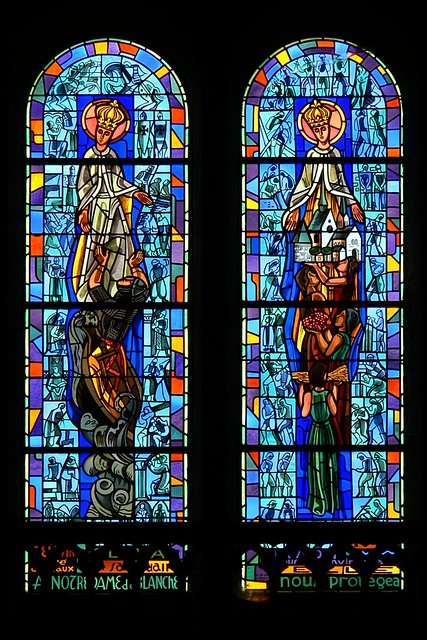Bodard and Gouffault

Gaston de Bodard (1897–1980) was a painter and designer active in the mid-20th century, known for his ecclesiastical work throughout the Loire region. Trained as a decorative artist, he brought to stained glass a modernist clarity of form and colour, often merging simplified geometry with expressive religious symbolism. His collaboration with Louis Gouffault produced a number of post-war church commissions that reflect the era’s spiritual optimism and regional identity.
Louis Gouffault (1898–1981), maître-verrier of Orléans, founded his studio around 1930 and became one of the foremost glassmakers of central France. After 1945 his workshop played a leading role in the restoration and renewal of church glazing, working with artists such as Gaston de Bodard and Henri-Marcel Magne. Gouffault’s craftsmanship is distinguished by his subtle modulation of colour, precise leading, and sensitivity to architectural light, qualities evident in the Pontlevoy window, where modern artistry and traditional technique coexist harmoniously.
his two-light stained glass window in the Church of Saint-Pierre, Pontlevoy, presents a modern devotional image of Notre-Dame de la Blanche, conceived in the years immediately following the Second World War. Designed by Gaston de Bodard and executed by the Orléans master-glazier Louis Gouffault, it unites traditional Marian iconography with a meditation on the enduring presence of conflict and divine protection through history.
In the left light, the Virgin stands above a soldier or knight, who reaches toward her in appeal. This figure, in armour and shadowed tones, represents both the combatant of medieval crusade and the modern soldier, embodying the universal human plea for mercy in times of war.
The right light shows the Virgin as Protector of Pontlevoy, crowned and radiant, holding a model of the church in her arms. Women offer wheat and grapes, symbols of renewal, sacrifice, and the Eucharist.
In both panels the surrounding mosaic-like panels, composed of angular shards of vivid blue, crimson, and gold, depict scenes of battle on both sides. These fragmented vignettes of soldiers and knights in combat bind the imagery of medieval warfare and twentieth-century devastation into a single visual continuum, suggesting that divine compassion endures across centuries of human strife.
The inscription along the base, “À Notre-Dame de la Blanche – priez pour nous”, dedicates the window as a votive act of gratitude for the protection of Pontlevoy during the Second World War. The geometric precision of the composition, the crystalline rhythm of the leading, and the radiance of its colour exemplify Gouffault’s technical mastery and de Bodard’s expressive modernist vision.
The imagery of the Notre-Dame de la Blanche window resonates deeply with Pontlevoy’s layered identity as both a medieval abbey and a community shaped by the traumas of modern warfare. The military mosaics flanking both lights unite the armed knights of the Middle Ages with the soldiers of the twentieth century, expressing a continuity of human struggle across time. In this synthesis of sacred and martial imagery, Gaston de Bodard and Louis Gouffault evoke a vision of enduring divine guardianship: the Virgin who once protected crusaders and pilgrims now shelters the town from the devastations of modern conflict.
This fusion of past and present situates the Pontlevoy window within the broader post-war spiritual renewal of French stained glass, where artists sought to reconcile faith with the memory of loss. The Virgin’s calm centrality amid fields of battle transforms the window into an image of compassion and endurance, a visual prayer for reconciliation and peace, grounded in both local devotion and national remembrance.
